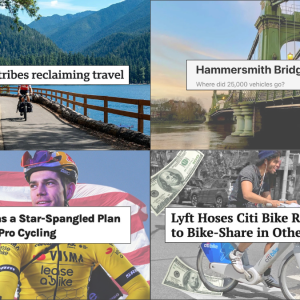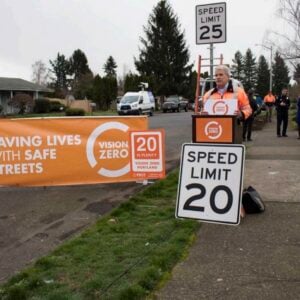Welcome to my mostly-weekly video roundup! Today seems as good as any other day to watch bike videos. Right? I’ve watched about 100 bike videos this week so I can share the best with you.
We’re starting on a safety/wonky/political note this week- a fantastic overview of Vision Zero. Watch the first 40 seconds for this: “mobility is a basic human right. No one should have to risk their life to get to work, to go shopping, or to go out with a friend.” While talking about systematic safety, “we’re human, a system that is safe only if people don’t make mistakes is not a system that is made for humans.”
Russ and Laura of Path Less Pedaled were in Los Angeles recently and posted our first video- riding Mt. Lowe Road to Mueller Tunnel. It’s an incredible climb, over 3000 feet in 8 miles.
People have been laughing at this video where cyclists attempt to pull a mountainbike off of an electric fence. I don’t know what’s funnier- the antics or the accents. (warning: colorful language, I think.)
Here’s some Brunelle. It’s just a snippet, but the weather on New Years looks much better than ours did.
I was never good at playing H.O.R.S.E. in basketball. I think I’d fail B.I.K.E. too. Still, it looks like a fun drinking game.
Russ and Laura also narrated a gravel-grinding ride in Los Angeles on the Verdugo Mountains– just outside Burbank, in fact. There are really interesting little pockets of Los Angeles that are surprising and amazing.
GMBN has tips for climbing 1000m (3000ft) on a mountain bike. It’s very helpful for road cyclists too. (my #1 tip is to climb using a heartrate monitor)
For those who are training through the winter, here are some tips from GCN: (also: 4 training session ideas)
London’s cycling infrastructure is looking fantastic. They have problems, but it shows how far a city can get by making a commitment to improve their roads. I still cringe when I see oncoming traffic on the ‘wrong’ side of the street.
They have similar problems to us, though, here’s a car in the bike lane. Check out the 1:25 mark where they are held up by traffic. (also: a cyclist doing bad)
Cycling anime. Interested? You’ll like this. There are some pretty legit road bike racing anime series in there.
I covered this in the past, but here’s another video about the Isla Bikes reusable bike program:
https://www.youtube.com/watch?v=IXktCRkgly8
It’s not all about speed, right? GMBN looks for the fun lines instead of the fast lines:
Advertisement
NPR Youtube series Skunk Bear did an episode exploring if you can power your house with your bicycle.
Women-specific bike design is a thing- for good reason. Women aren’t just smaller men. This BikeRadar piece gives a good overview of these designs, from bad to good.
Ray of DC Rainmaker showed what Zwift looks like on a VR headset (like Oculus Rift). He talks about the advantages and disadvantages- basically, it’s mostly a gimmick.
It takes about 90 seconds before he goes through the list, but there are a lot of tactile patterns on sidewalks to help the blind. I know these exist to some extent in the US also.
This “bunnyhop battle” is sort of the reverse version of a limbo contest.
Travel Oregon released a video about the Painted Hills Scenic Bikeway. I rode this and loved it– something makes me think PLP has ridden it too.
Honorable Mentions
This week’s honorable mentions: 11 minutes of Brumotti breathing heavily, stunt riding overlaid with political audio clips.
Inclusion criteria: If I’ve missed something, post it in the comments! I prefer videos published in the last week or so. Note if there’s a specific point in a long video that is worth highlighting. Also note if there is colorful language. I will delay videos containing pro racing spoilers by 7 days.
– Ted Timmons, @tedder42 on Twitter
BikePortland is supported by the community (that means you!). Please become a subscriber or make a donation today.







Thanks for reading.
BikePortland has served this community with independent community journalism since 2005. We rely on subscriptions from readers like you to survive. Your financial support is vital in keeping this valuable resource alive and well.
Please subscribe today to strengthen and expand our work.
That Vision Zero video is definitely worth the watch.
The London infrastructure looks downright dangerous. Not to seasoned users, but to those not familiar with it. Too many narrow little sections for cars, peds, bike. If anyone at any point in the system misses the markings or has a moment of distraction, the result will be very bad indeed.
And yet, it is still significantly safer than what we have here.
They have about as many useless red lights in it. At 3:01 – why?!
Good video but somewhat misleading. Here are the stats on fatalities per 1 billion km driven:
Sweden 3.5
Netherlands 4.5
USA 7.1
https://en.wikipedia.org/wiki/List_of_countries_by_traffic-related_death_rate
So, we’re not doing as bad as the video would have you to believe. Of course we can improve and with Ds in absolute power in PDX you have an opportunity to show what you can do. There is no opposition and if there is, just shut ’em down and do what you want anyway – your city and county government will probably back you.
Fatalities-per-distance are a terrible metric. It “penalizes” places that have shorter trip distances, lower percentage of car drivers, etc.
It also normalizes the fatalities.
So, fatalities per 100k population, from the same source:
Sweden 2.8
Netherlands 3.4
USA 10.6
Ted, your reply is just flat incorrect. “Your” stats on fatalities per population ignores how much driving is actually happening. Of course European nation have lower fatality rates based on population – they DRIVE LESS on a per capita basis.
Take a statistics class please.
When viewing statistics on any topic, you must be able to determine what is relevant, and what is noise. [removed unnecessary politics -ted]
You say driving less like it’s a bad thing.
He says it like it’s a relevant factor that should be considered when trying to understand the relative safety/danger of a road network.
But on the flip side of that, the Dutch cycle WAY more than even the Swedes and certainly Americans. And not just more people, but that also involves every single demographic, including small kids and elderly people commuting around cities or between cities, etc. So to still achieve a much lower fatality rate for cycling is very clearly indicative of that.
The Dutch drive less for sure, since there’s way more cycling and usage of public transportation. But there are still way too many cars here. Especially in the smaller towns and villages, people drive more proportionately.
I agree with Ted here as the amount of driving is a factor in evaluating Vision Zero. Reducing driving is a way to reduce traffic fatalities so it makes sense to account for (or “reward”) these efforts.
Only looking at distance driven does not account for efforts not involving vehicles that cities take to reduce traffic deaths. If a population can meet transportation needs with fewer deaths that should be accounted for regardless of the amount of driving vs other transportation. If Vision Zero was just about reducing deaths with driving than you would be right, but I believe it should have a larger scope regarding how populations meet transportation needs.
SA,
So, all the US needs to do is drive more without more deaths occurring?
Lies, damn lies and statistics.
EU mileage is typically all trips, while US mileage is typically just work commute. The OECD reports both rates, but population would take in more forms of transportation, like walking or biking, than miles cars are driven. Also, car fatalities tend to be about 60% of the US fatalities. What are the ratios for EU?
Both metrics can be useful. They’re just metrics, they measure things differently.
For example, my perspective: Our goal ought to be to reduce the rate of deaths per-population, including by reducing driving, but also by other means. If we want to understand how we’re doing overall, we need to look at the top-line number (deaths per-population); if we want to understand how our road design is doing, it makes more sense to look at it per-mile-driven.